The art of public speaking involves more than just voice delivery. Body language, which refers to the nonverbal cues presented to the audience through posture, gestures, and facial expressions, is an essential skill to acquire.
Body language plays a crucial part in public speaking since it greatly affects how the audience interprets the speaker and their message. A speaker who projects confidence and credibility through their body language can captivate an audience and eventually improve the effectiveness of their speech. A speaker’s message can be undermined by negative body language, which can also make the audience disconnect or lose interest.
In this article, we’ll look at a variety of body language techniques you may use to improve your public speaking, as well as audience engagement advice that can help you feel more confident. You may deliver a strong and captivating presentation that makes an impression using these strategies.
1. Getting better with practice:
There are numerous sensible pieces of advice on how to engage an audience through body language. It’s important to maintain eye contact, maintain an open posture, and remain as close to your audience as you can.
There is undoubtedly a catch even if using these body language indicators can be successful.
According to research, students who leaned while working on math problems outperformed those who sat up straight, according to Psychology Today’s Nick Morgan. Researchers came to the conclusion that students who were more at ease used more brain cycles than those who sat erect.
“This research suggests that paying attention to your body language with your conscious mind may divert some brain cycles away from thinking about the content of your speech.” Morgan says.
“Your conscious mind is capable of processing information at a rate of about 40 bps. That’s not much, so typically, your unconscious mind, which can manage approximately 11 million bps, does the majority of the vital work of keeping you moving, walking, talking, and chewing gum. You wouldn’t have to think about it (consciously), and public speaking would be a little simpler if your unconscious mind worked in a way that naturally caused you to assume a certain posture before you spoke and then maintain that posture while speaking.”
These results imply that in order to organically incorporate good body alignment and movement into your presentations, practice is extremely necessary. You must practice in a setting that allows you to move around freely, just like you would on stage, in order to effectively incorporate good body language into your talks. Finding a space where you can move about freely and make gestures, as you would in a genuine presentation, entails doing this.
You will grow more at ease and assured in your stage motions with practice, which will free you up to concentrate more on the presentation’s substance and delivery.
2. Facial expressions
Pay attention to your facial expressions as you practice incorporating certain body language clues into your presentations. The main weapon for expressing emotion and sincerity in your message is your face. The audience can better understand your speech’s tone and emotionally relate to your content by watching your facial expressions.
It’s critical to monitor your facial expressions as you speak. Your listeners can find your speech boring or uninteresting if you have a monotone expression or appear uninterested. However, an extremely expressive or dramatic look could come out as forced or forcedly honest.
Making videos of yourself while you practice facial expressions is one approach to improve. You’ll have a better notion of how you appear to your audience as a result, and you’ll be able to modify your facial expressions accordingly.
Try to maintain eye contact with various audience members during the presentation, and adjust your facial expressions to match the tone of your speech. Use a serious face when communicating a serious message, and try to grin or project a lighthearted demeanor when sharing a hilarious narrative.
3. Power poses
Power poses are a common strategy for enhancing body language. Standing or sitting in specific positions that are thought to encourage confidence, assertiveness, and authority are referred to as power poses.
Following a 2012 TED Talk by social psychologist Amy Cuddy, the concept of power poses became well known. Prior to a stressful event, such as a job interview or presentation, Cuddy asserted that striking a power pose could raise testosterone levels, lower cortisol levels, and boost performance. Other scientists, who were unable to duplicate Cuddy’s findings, eventually disputed her assertions.
This argument sparked a contentious discussion regarding the usefulness of power postures. Even though there is conflicting scientific evidence about power poses, many people still believe them to be beneficial for increasing confidence and lowering anxiety before presentations.
Think about trying out some power poses to see if they are effective for you. The Wonder Woman posture, the Superman pose, and the Victory pose are just a few of the many power poses available.
Select poses that are natural and comfortable for you and check to see if your confidence changes as a result. If your self-assurance grows, you might use these stances both before and during your presentation.




